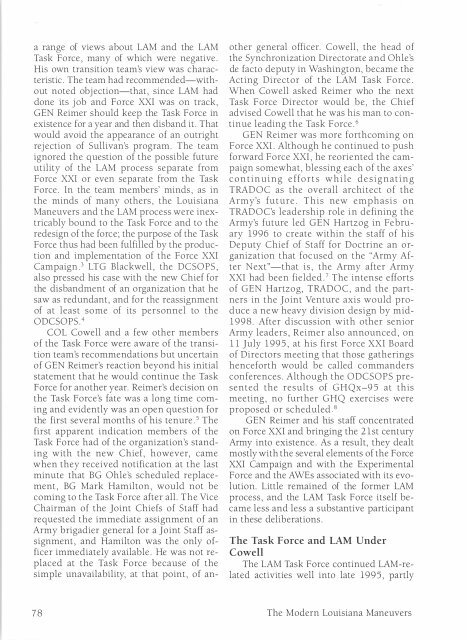The Modern Louisiana Maneuvers - US Army Center Of Military History
The Modern Louisiana Maneuvers - US Army Center Of Military History
The Modern Louisiana Maneuvers - US Army Center Of Military History
You also want an ePaper? Increase the reach of your titles
YUMPU automatically turns print PDFs into web optimized ePapers that Google loves.
a range of views about LAM and the LAM<br />
Task Force, many of which were negative.<br />
His own transition team's view was characteristic.<br />
<strong>The</strong> team had recommended-without<br />
noted obj ection-that, since LAM had<br />
done its job and Force XXI was on track,<br />
GEN Reimer should keep the Task Force in<br />
existence for a year and then disband it. That<br />
would avoid the appearance of an outright<br />
rejection of Sullivan's program. <strong>The</strong> team<br />
ignored the question of the possible future<br />
utility of the LAM process separate from<br />
Force XXI or even separate from the Task<br />
Force. In the team members' minds, as in<br />
the minds of many others, the <strong>Louisiana</strong><br />
<strong>Maneuvers</strong> and the LAM process were inextricably<br />
bound to the Task Force and to the<br />
redesign of the force; the purpose of the Task<br />
Force thus had been fulfilled by the production<br />
and implementation of the Force XXI<br />
Campaign 3 LTG Blackwell, the DCSOPS,<br />
also pressed his case with the new Chief for<br />
the disbandment of an organization that he<br />
saw as redundant, and for the reassignment<br />
of at least some of its personnel to the<br />
ODCSOPS.4<br />
COL Cowell and a few other members<br />
of the Task Force were aware of the transition<br />
team's recommendations but uncertain<br />
of GEN Reimer's reaction beyond his initial<br />
statement that he would continue the Task<br />
Force for another year. Reimer's decision on<br />
the Task Force's fate was a long time coming<br />
and evidently was an open question for<br />
the first several months of his tenure.5 <strong>The</strong><br />
first apparent indication members of the<br />
Task Force had of the organization's standing<br />
with the new Chief, however, came<br />
when they received notification at the last<br />
minute that BG Ohle's scheduled replacement,<br />
BG Mark Hamilton, would not be<br />
coming to the Task Force after all. <strong>The</strong> Vice<br />
Chairman of the Joint Chiefs of Staff had<br />
requested the immediate assignment of an<br />
<strong>Army</strong> brigadier general for a Joint Staff assignment,<br />
and Hamilton was the only officer<br />
immediately available. He was not replaced<br />
at the Task Force because of the<br />
simple unavailability, at that point, of an-<br />
78<br />
other general officer. Cowell, the head of<br />
the Synchronization Directorate and Ohle's<br />
de facto deputy in Washington, became the<br />
Acting Director of the LAM Task Force.<br />
When Cowell asked Reimer who the next<br />
Task Force Director would be, the Chief<br />
advised Cowell that he was his man to continue<br />
leading the Task Force. 6<br />
GEN Reimer was more forthcoming on<br />
Force XXI . Although he continued to push<br />
forward Force XXI, he reoriented the campaign<br />
somewhat, blessing each of the axes'<br />
continuing efforts while designating<br />
TRADOC as the overall architect of the<br />
<strong>Army</strong>'s future. This new emphasis on<br />
TRADOCs leadership role in defining the<br />
<strong>Army</strong>'s future led GEN Hartzog in February<br />
1996 to create within the staff of his<br />
Deputy Chief of Staff for Doctrine an organization<br />
that focused on the "<strong>Army</strong> After<br />
Next"-that is, the <strong>Army</strong> after <strong>Army</strong><br />
XXI had been fielded.7 <strong>The</strong> intense efforts<br />
of GEN Hartzog, TRADOC, and the partners<br />
in the Joint Venture axis would produce<br />
a new heavy division design by mid-<br />
1998. After discussion with other senior<br />
<strong>Army</strong> leaders, Reimer also announced, on<br />
11 July 1995, at his first Force XXI Board<br />
of Directors meeting that those gatherings<br />
henceforth would be called commanders<br />
conferences. Although the ODCSOPS presented<br />
the results of GHQx-95 at this<br />
meeting, no further GHQ exercises were<br />
proposed or scheduled B<br />
GEN Reimer and his staff concentrated<br />
on Force XXI and bringing the 21st century<br />
<strong>Army</strong> into existence. As a result, they dealt<br />
mostly with the several elements of the Force<br />
XXI Campaign and with the Experimental<br />
Force and the AWEs associated with its evolution.<br />
Little remained of the former LAM<br />
process, and the LAM Task Force itself became<br />
less and less a substantive participant<br />
in these deliberations.<br />
<strong>The</strong> Task Force and LAM Under<br />
Cowell<br />
<strong>The</strong> LAM Task Force continued LAM-related<br />
activities well into late 1995, partly<br />
<strong>The</strong> <strong>Modern</strong> <strong>Louisiana</strong> <strong>Maneuvers</strong>
















